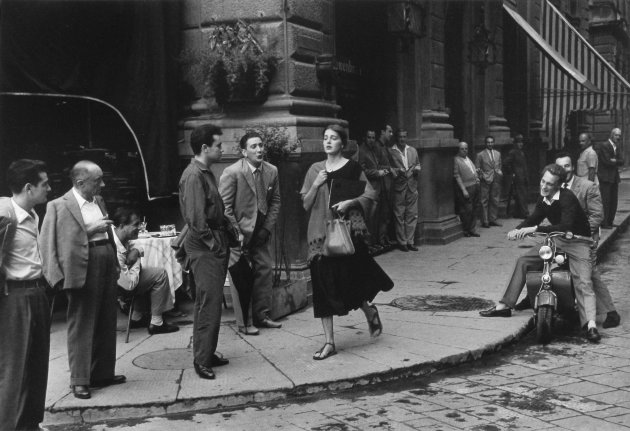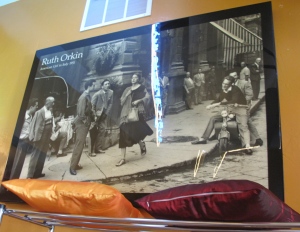It’s the 60 year anniversary of the famous photograph “American girl in Italy” and the subject of the photo is speaking out.

Last year, I discovered the photo when I saw it at a restaurant. I looked it up and blogged about it. To me, it looked like a very upsetting street harassment experience, especially based on the look on the woman’s face. A few weeks ago the woman in the photograph, Ninalee Craig, commented on my blog post and I was surprised by what she wrote. She said,
“I was that young woman in the photograph. I was 23 years old. It was taken at 10:30 in the morning. It was not set up, or posed. I was walking with confidence in Florence, a city I knew and loved. Yes, it was a corner filled with men, but not for one moment did any of them “harass” or disturb. It was an instant in which I was Beatrice, and among the men, might be a Dante. It was, and remains a delightful memory of an Italy that was. And, still is. Ninalee.”
I thought it was a prankster until someone sent me a link to a Globe and Mail article where Ms. Craig made a similar comment about the photo. Today someone tweeted to me a Yahoo article about it and the article quotes Ms. Craig’s recent appearance on the “Today” show:
“In her “Today” appearance, Craig spoke about how, despite what some might say, the photo isn’t a “symbol of harassment.” Craig insists that the image is “a symbol of a woman having an absolutely wonderful time.”
(I wonder what facial expression she makes when she’s having a miserable time because her “wonderful time” face looks like most people’s “miserable time” face!!)
Her comments beg the question: Does the photograph depict street harassment or not?
I believe that it does. Those men do not know her (she says it was not staged) and in a public place they are grabbing crotches and making faces that suggest they are uttering sexually objectifying comments and sounds. That is street harassment.
Ironically, the photograph was part of a series the photographer Ruth Orkin titled Don’t Be Afraid to Travel Alone, based on their joint experience as women traveling alone in Europe in the 1950s. Orkin photographed Craig shopping in the markets, crossing traffic, riding a carriage and flirting at a cafe. In my interpretation of it, that photo shows discomfort and maybe even fear. It would not entice me, as woman, to want to travel alone through Italy.
And in fact, in college, I originally wanted to study abroad in Italy, but I chose not to after I heard some terrible street harassment experiences from women who had been there (including a shop owner groping a family friend when she was in line to buy food). Italy has a misogynistic culture and street harassment is rampant. Consequently, Italy was one of three countries I highlighted in my book as being street harassment hot zones.
Ms. Craig, however, disagrees with my interpretation and feels it was not harassment and unproblematic.
Women don’t all agree with what is harassment and I’m glad she didn’t feel harassed. I’m glad she has fond memories of it.
I also know that when this photograph was taken, it was a different era. Back then no one knew the term street harassment or even sexual harassment and it was acceptable and expected behavior that women had to deal with. And she dealt with it and continued to have a good time in Italy. Wonderful.
But I can’t let it go at that. The behavior captured in the photograph IS problematic! It is street harassment even if the subject didn’t feel harassed. If someone is paid less for the same job as someone else because of their race and/or gender that is pay discrimination even if that person doesn’t feel discriminated against!
Street harassment is how some men exert male dominance and ownership over the streets and ensure that women who may not have the fortitude of Ms. Craig choose not to be in public alone, or feel discomfort when they are there. Do you see any other women on the street? No. That is a problem!
The men’s behavior contributes to the lack of gender equality in our society: it keeps women from having the same access to public spaces as men. Even if it doesn’t bother one individual, it bothers most women and contributes to a misogynistic culture.
Your thoughts?


